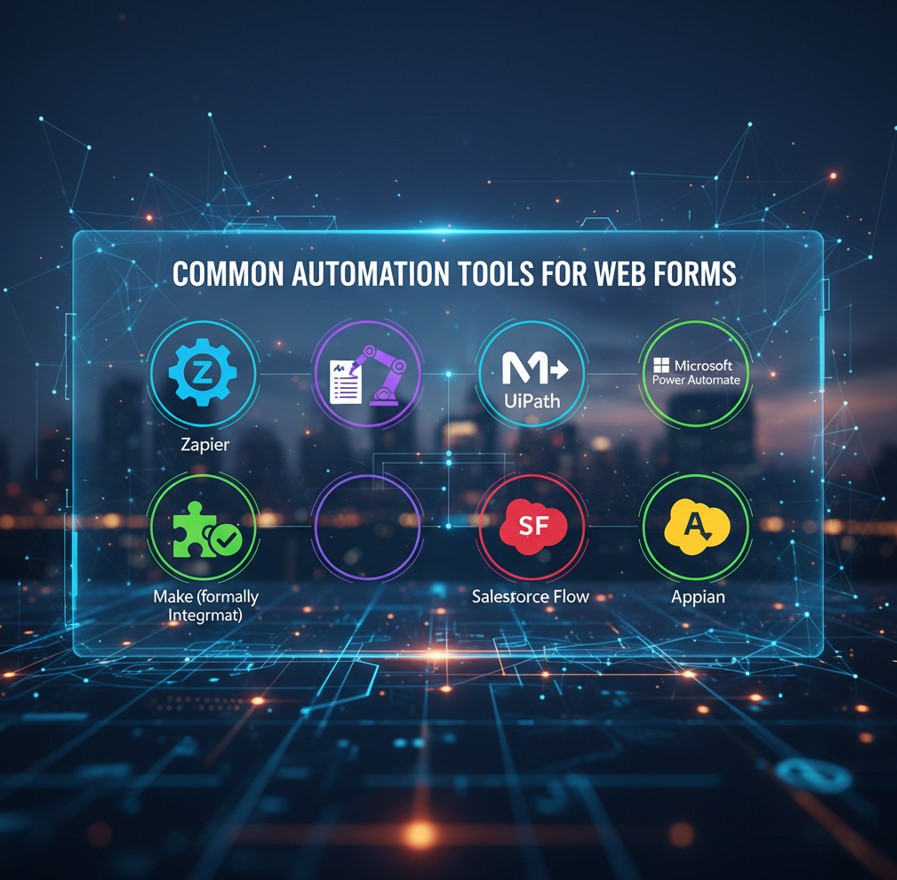The process of manually transferring data is repetitive, tedious, and susceptible to errors. For data entry clerks, business analysts, or even automation enthusiasts, automating data filling in web forms can save you a lot of time and increases the accuracy. This blog will introduce you to The benefits of automation, the tools to use, and a complete step-by-step process to get you started. This is your guide to automating web form data entry whether you are a professional trying to save time or an enthusiastic hobbyist.
Understanding Web Forms
Understanding the fundamentals of webforms is imperative to automating processes. Web forms are a means of structured data collection by websites from their users. These can be in the form of text fields, drop-down menus, checkboxes, radio buttons, etc. We will summarize each of the elements that will be available for you while automating web forms.

Key Components of Web Forms
- Input Fields: These elements allow users to type information, such as names, emails, or numbers.
- Dropdown Menus: Fields with multiple options, often used for selecting items like countries or categories.
- Radio Buttons/Checkboxes: Options for users to select single or multiple choices.
- Submit Button: The button that sends the completed form data to the server.
Automating web forms requires your automation tool to interact with these individual components. By identifying each element’s HTML attributes (such as id, name, or class), automation tools or scripts can locate and populate the fields without manual involvement.
Common Automation Tools for Web Forms
Several tools are available to help automate tasks such as data entry in web forms. Here are three of the most used solutions:

1. Selenium
Selenium is a widely used open-source tool for browser automation, particularly popular among developers. It allows you to simulate user actions like typing, clicking, and navigating across websites. Selenium supports multiple programming languages, including Python, Java, and JavaScript.
2. UiPath
For those looking for a low-code or no-code option, UiPath is a robust Robotic Process Automation (RPA) tool. It provides drag-and-drop workflows, making it accessible for those without advanced programming skills. UiPath also offers advanced features like screen scraping and data extraction.
3. Custom Scripts
If you’re comfortable with coding, creating custom scripts in programming languages like Python, using libraries such as BeautifulSoup for scraping or requests for API interaction, can be a cost-effective and tailored solution.
Each tool has its strengths and use cases. Your choice will likely depend on technical proficiency, budget, and the complexity of the task.
Step-by-Step Guide to Automate Data Entry in Web Forms
Here’s a practical guide to help you automate data entry using Selenium as an example:
Step 1. Install Selenium Framework
First, install Selenium using your preferred package manager. If you’re using Python, run the following command in your terminal:
“`
pip install selenium
“`
Step 2. Download WebDriver for your Browser
Selenium requires a WebDriver to interface with your browser (e.g., Chrome Driver for Google Chrome). Download the WebDriver compatible with your browser version and configure the path to it in your script.
Step 3. Load the Web Form
Write a script to open the target web form. Start by importing Selenium and initializing your WebDriver:
“`python
from selenium import web driver
driver = webdriver.Chrome(“path_to_chromedriver”)
driver.get(“http://example.com/webform”)
“`
Step 4. Locate Form Elements
Locate the fields you need to fill out using methods like find_element_by_id, find_element_by_name, or find_element_by_xpath:
“`python
name_field = driver.find_element_by_name(“name”)
email_field = driver.find_element_by_name(“email”)
submit_button = driver.find_element_by_xpath(“//button[@type=’submit’]”)
“`
Step 5. Automate Data Entry
Populate the fields using Selenium’s send_keys method:
“`python
name_field.send_keys(“John Doe”)
email_field.send_keys(“[email protected]”)
“`
Step 6. Submit the Form
Click the submit button using Selenium’s click method:
“`python
submit_button.click()
“`
Step 7. Handle Feedback or Errors
After submission, handle any error messages or confirmations dynamically:
“`python
confirmation_message = driver.find_element_by_id(“confirmation”).text
print(“Form submitted successfully:”, confirmation_message)
“`
Step 8. Close the Browser Session
Finish by closing the browser session:
“`python
driver.quit()
“`
Congratulations! You’ve successfully automated your first data entry process in a web form.
Best Practices for Data Entry Automation
A robust automation process requires thoughtful planning and implementation. Here are some best practices to keep in mind:

1. Implement Error Handling
To ensure a successful automation process, use try-except blocks in your scripts to catch and handle errors correctly. This is especially important for cases where web forms behave unpredictably.
2. Validate Entered Data
Ensure that the right data is entered into the correct fields. Perform validations against field types and formats (e.g., email formats, phone number lengths).
3. Dynamic Element Handling
Web forms can dynamically generate elements such as Captchas or drop-down lists. Use techniques like waiting (explicit or implicit) to handle such cases.
4. Automate Scheduling
Set up your automation to run on a schedule using task schedulers or crone jobs. For instance, create weekly or nightly submissions based on your workload.
5. Keep Browser Drivers Updated
Always update your browser and WebDriver to maintain compatibility and avoid errors caused by version mismatches.
Real-World Examples of Data Entry Automation
Here are two examples showcasing how automation transformed data entry processes:
Case Study 1: Reducing Time in Competition Data Entry
A marketing agency used UiPath to fill competition entry forms, retrieving data from spreadsheets. This reduced manual entry time by 80% and eliminated errors caused by fatigue.
Case Study 2: Streamlining Insurance Claims Processing
An insurance company leveraged Selenium to automate data entry from scanned forms into web-based insurance claim tools. Using Python, they created a script that extracted data using OCR (optical character recognition) and populated forms with 99% accuracy.
Both scenarios saved significant time, reduced error rates, and allowed employees to focus on higher-value tasks.
Unlock Efficiency with Automation
Filling up web forms automatically can be a godsend for clerks, analysts and hobbyists. It releases time for more strategic work and secures error-free accuracy by minimizing manual labor and optimizing efficiency.
Begin experimenting today if you want to streamline repetitive processes or explore more automation tools. Scripts in Selenium, workflows in UiPath, there is always something to reduce your workload with automation.
Get your hands dirty, and build your first automated entry script. You’ll wonder what you did without it!










